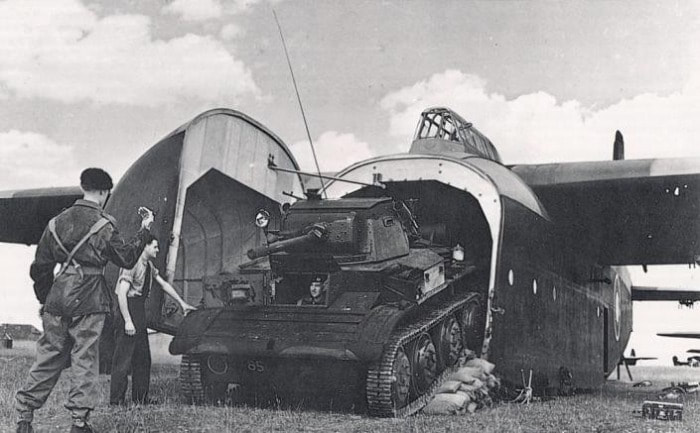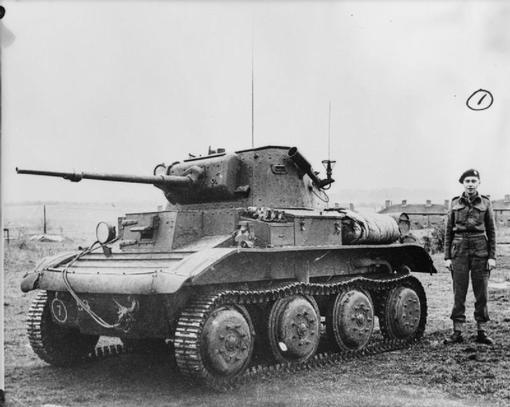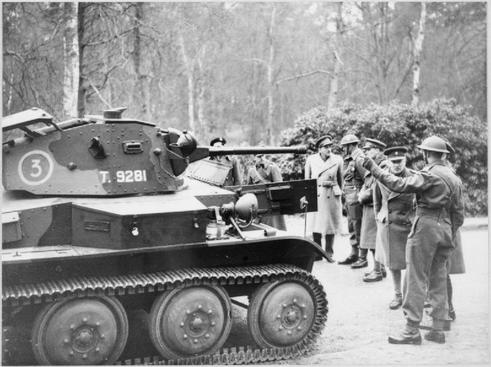The Tetrarch Tank
 A Tetrarch leaves a Hamilcar. Note the tight fit that required drivers to remain in the tank during flight.
A Tetrarch leaves a Hamilcar. Note the tight fit that required drivers to remain in the tank during flight.
Because of a lack of equipment training facilities in mid-1940, when the British airborne establishment was formed, the War Office was able to accept only 500 volunteers for training as airborne troops. Progress in setting up proper training facilities and acquiring suitable transport aircraft was so slow that the first British airborne operation, Operation Colossus, was conducted by a retrained Commando unit. By 1942, there existed specifically trained airborne units, including the 1st Airborne Division, and on 19 January 1942 the War Office decided that a light tank unit would be one of the support units attached to the division. This unit, designated the Light Tank Squadron, was to be formed of nineteen light tanks and would operate to the fore of the division, using their tanks' speed to capture objectives and then holding them until relieved by other units. The obvious unit for conversion was 'C' Special Services Squadron, as it was trained to act as an independent tank unit and, more importantly, was the only unit that was still using Tetrarchs; it had been re-designated as an airborne tank by the War Office. 'C' Squadron was officially transferred to the 1st Airborne Division on 24 June 1942, bringing with it seven Tetrarchs among its other vehicles. The unit immediately began training, but was not attached to the 1st Airborne Division for long; during mid-1943, the division was transported to the Middle East so it could participate in the Allied invasion of Sicily. 'C' Squadron remained in Britain, as not enough Hamilcar gliders had been built by the time the division departed to transport its Tetrarchs; the squadron was transferred to the 6th Airborne Division, which had been raised in April 1943, and 'C' Squadron remained with it for the rest of the conflict. The squadron continued to train as an air-portable unit, and participated in a number of exercises to prepare for its new duties, including reconnaissance of enemy positions and counter-attacking enemy infantry and armour.
 A view of a Tertrarch Tank. Some of those used on D-Day were fitted with 7.62mm machine guns in a close support role.
A view of a Tertrarch Tank. Some of those used on D-Day were fitted with 7.62mm machine guns in a close support role.
On 13 December 1943, the War Office decided to expand the squadron into a regiment equipped with a combination of light tanks and conventional reconnaissance vehicles such as scout cars, and on 1 April 1944, it was re-designated as the 6th Airborne Armoured Reconnaissance Regiment. The regiment consisted of a Headquarters Squadron, a Light Tank Squadron and a Reconnaissance Squadron; two Tetrarchs, the Mark 1 CS (Close Support) variation (which had their 40 mm gun rplaced by a 7.62 mm machine gun), were attached to the Headquarters Squadron, but the Light Tank Squadron, also known as 'A' Squadron, received the majority of the Tetrarchs. 'A' Squadron had approximately nineteen Tetrarchs split between six troops, two of which were of the CS variation and the rest were armed with 2 pounders fitted with Littlejohn adaptors. On 24 May 1944, after participating in a further series of exercises and manoeuvres, 'A' Squadron moved from their training area to a transit camp at Tarrant Rushton airfield, while the rest of the regiment moved to RAF Brize Norton airfield the next day; from these two airfields, the regiment would be transported from to participate in the British airborne landings in Normandy.[45] The operation began on the night of 5 June, with the deployment of 6th Airborne Division to eastern Normandy. It was tasked with protecting the eastern flank of the Allied seaborne landings, securing strategically important areas east of Caen, capturing several important bridges over the Caen Canal and River Dives, and destroying a coastal artillery battery.[46] Insufficient transport aircraft were available to land all three of the division's brigades simultaneously; one would have to be landed in a second lift later in the day. Major General Richard Gale had initially intended for the 6th Airlanding Brigade, to which the 6th Airborne Armoured Reconnaissance Regiment was attached, to be landed first; however, aerial photography revealed that anti-glider poles had been erected in the landing zone selected for the brigade. Therefore, Gale decided that the 3rd Parachute Brigade and 5th Parachute Brigade (which did not utilise gliders) should land in the first lift to clear the landing zones, allowing the 6th Airlanding Brigade to land in the second lift.
Hamilcar gliders of 6th Airlanding Brigade arrive on Drop Zone 'N' carrying Tetrarch tanks, 6 June 1944.
The Horsa and Hamilcar gliders of the brigade landed at 21:00 on 6 June in a landing zone cleared of obstructions by the 5th Parachute Brigade. The primary tasks of the brigade were to bring in reinforcements and supplies, and to aid the two parachute brigades in consolidating the area held by the division; the 6th Airborne Armoured Reconnaissance Squadron was to aid in the latter task, acting as a reconnaissance force to scout out German positions and impede the movement of German forces attempting to counter-attack. The Tetrarchs of 'A' Squadron were to play an integral part in this reconnaissance role due to their speed, but the squadron's strength of twenty tanks was severely depleted by the time it landed in Normandy. It lost one tank before the formation landed when the Tetrarch broke loose of its shackles and crashed through the nose of the glider that was carrying it, causing both to fall into the sea mid-flight. The squadron's strength was further weakened when two gliders collided with each other in the landing zone, destroying themselves and the Tetrarchs they carried; a third Hamilcar hit another Tetrarch as it was being unloaded and flipped the tank upside down, rendering it unusable, although the crew escaped without injury. The surviving tanks were then rendered temporarily immobile when parachute rigging lines became tangled in their suspensions, forcing their crews to cut the lines away with welding torches.
Hamilcar gliders of 6th Airlanding Brigade arrive on Drop Zone 'N' carrying Tetrarch tanks, 6 June 1944.
The Horsa and Hamilcar gliders of the brigade landed at 21:00 on 6 June in a landing zone cleared of obstructions by the 5th Parachute Brigade. The primary tasks of the brigade were to bring in reinforcements and supplies, and to aid the two parachute brigades in consolidating the area held by the division; the 6th Airborne Armoured Reconnaissance Squadron was to aid in the latter task, acting as a reconnaissance force to scout out German positions and impede the movement of German forces attempting to counter-attack. The Tetrarchs of 'A' Squadron were to play an integral part in this reconnaissance role due to their speed, but the squadron's strength of twenty tanks was severely depleted by the time it landed in Normandy. It lost one tank before the formation landed when the Tetrarch broke loose of its shackles and crashed through the nose of the glider that was carrying it, causing both to fall into the sea mid-flight. The squadron's strength was further weakened when two gliders collided with each other in the landing zone, destroying themselves and the Tetrarchs they carried; a third Hamilcar hit another Tetrarch as it was being unloaded and flipped the tank upside down, rendering it unusable, although the crew escaped without injury. The surviving tanks were then rendered temporarily immobile when parachute rigging lines became tangled in their suspensions, forcing their crews to cut the lines away with welding torches.
 In a glider you say? A glider?
In a glider you say? A glider?
The squadron retrieved all of the remaining Tetrarchs and advanced to the south of the landing zone to link up with the rest of the regiment; there, they received orders to support the 8th Parachute Battalion in the Bois de Bavent area and conduct reconnaissance duties. After linking with the battalion, the squadron began reconnoitring, and engaged German infantry and armour they encountered. By the end of 7 June, two Tetrarchs had been lost to enemy action, one destroyed by a German self-propelled gun and the second by hitting a mine. The division was reinforced by British troops who were advancing from the invasion beaches and it began to push through Normandy, while the squadron continued its reconnaissance duties. At this time, Gale decided to avoid, when possible, engaging the Tetrarchs with German armour, as they proved to be completely outclassed by the German tanks and self-propelled guns, such as the Panzer IV and the Sturmgeschütz III. Instead, when the division required armoured support, it summoned it from armoured units outside the division, and the Tetrarchs were used to support infantry patrols and provide fire support.[56] By August, in the division's preparation for the planned breakout from the Normandy bridgehead, the majority of Tetrarchs in 'A' Squadron were replaced with Cromwell fast cruiser tanks; only three Tetrarchs remained, assigned to the Headquarters troop of 'A' Squadron.